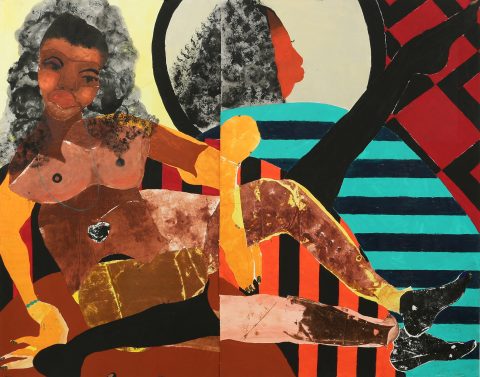Emerging artist Tschabalala Self and the collective fantasies surrounding the black body
- Tschabalala Self, Spare Moment, oil, pigment, fabric and acrylic on canvas, inch 4,2 x 6,4, 2015.Courtesy of Tschabalala Self @ The La Brea Studio Residency; Los Angeles, California.
- Tschabalala Self, Pink eye, oil, pigment, fabric and acrylic on canvas, inch 3,2 x 4,4, 2015. Courtesy of Tschabalala Self @ The La Brea Studio Residency; Los Angeles, California.
- Tschabalala Self, Awakening, oil, pigment and acrylic on canvas, inch 4 x 6, 2015. Courtesy of Tschabalala Self @ The La Brea Studio Residency; Los Angeles, California.
- Tschabalala Self, Pieces of Me, oil and acrylic on paper, inch 60″ x 44″, 2015. Courtesy of Tschabalala Self @ The La Brea Studio Residency; Los Angeles, California.
In the art works of Tschabalala Self (b. 1990), identity is not a given. Her subjects are always formed precisely in the moment of being seen. The self (small ‘s’) is only ever made complete by the eyes of the onlooker. Despite the artist’s young age and having completed her MFA course at the Yale School of Arts only last year, Tschabala Self already stands with a large and impressively coherent body of work behind her. Working mostly with paint and printed fabrics (occasionally with sculpture and animation) Self’s work centres around depictions and preconceptions of the black female body in contemporary America. She writes, “Collective fantasies surround the black body, and have created a cultural niche in which exists our contemporary understanding of black femininity. My practice is dedicated to naming this phenomenon”.
Self grew up in a large family Harlem, an area long synonymous with black culture and identity”. My mother and my three older sisters were the first women in my life, along with my caregiver Ms. Robinson (Ma)” explains Self. “My father and older brother were also in the home but were outnumbered by my sisters and I”. After completing the Bachelor program at Bard college, Self move out to New Hampshire for her graduate course and now splits her time between there and New York. Despite the high level of craft and attention evident in her work, Self is hugely prolific. In 2015 alone, the same year she completed her MFA at the Yale School of Art, the artist produced more than 20 full scale works in a variety of media.
There is an internal consistency to Self’s practice – not only in the visual patterns and repeated motifs that recur across pieces but in the highly directed subject matter. For all of Self’s pieces, what is at stake here is a politics of how the black female body is to be shown and how it is to be seen. Self’s subjects are bold and figurative, they twist themselves into impossible shapes – but for whom do they do this? The black women who populate Self’s images neither indulge the cultural fantasies projected onto them, nor do they completely reject them.
The bodies Self depicts are necessarily representations. That is, her subjects’ presence in the gallery not only comes into contact with the outside gaze of the viewer, but with the gaze of artist as well who decides in which form her subjects will present themselves. In itself, of course, this is unremarkable (the same could be said of any portrait) but in Self’s work, the relationship of artist to subject to viewer is complicated by a sophisticated play of identification. Self’s images are dynamic because the Artists stance and location is never clear. She is able to identify as both her subject and her viewer, like an actor switching effortlessly between the two roles. “My project is committed to this exchange”, she writes.
The disembodied eye (the disembodied ‘I’ perhaps) is amongst the most immediately recognisable motifs recurring in Self’s work. Through the printed and repeated eyes of works like Spare Moment, Open, or Pink Eye, the canvas looks back at its viewer. It mutely meets and multiplies the outside gaze. But whose eyes are they that stare back at us from the canvas? Those of the artist? Her subjects? Or are they our own eyes reflected back at us? It is no surprise, given this complex play of gazes, that much of Self’s work brings to mind the fracturing and flattening techniques of the early cubist painters. For the cubists, such a style of depiction was an attempt to show multiple viewpoints on the one object – all compressed into a single picture frame. For Self, these multiple viewpoints stand in for the eyes of varied onlookers, each forming the black feminine body according to their own fantasies. The bodies depicted by Self, therefore, are necessarily fractured. They do not hold the apparent ‘certainty’ of a fixed perspective but are instead assembled by the confluence of cultural projections.
For any social group, save those in power, identity is a process of constant negotiation between gazes. The I (‘eye’) is in perpetual dialogue with the other. In an oft-quoted line from ‘The Invisible Man’, Ralph Ellison’s now classic novel of Black America, the protagonist writes “I am invisible, understand, simply because people refuse to see me”. For Tschabala Self, as for Ellison, what is at question is not only visibility (the fact of being seen) but the more pressing concern of how one is to be seen. She writes, “I am attempting to provide alternative, and perhaps fictional explanations for the voyeuristic tendencies toward the gendered and racialized body; a body which is both exalted and abject”. Self’s art provides politics of how to be seen. Tchabalala Self’s first solo show in Europe open’s March 17 at T293, Italy.
January 25, 2016






